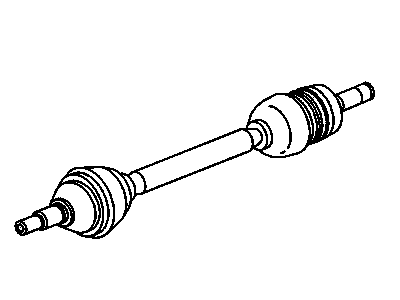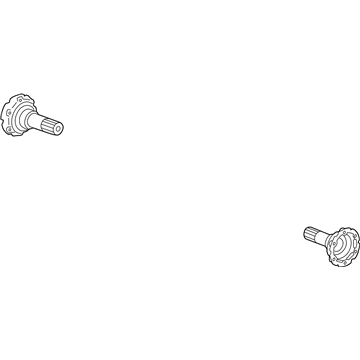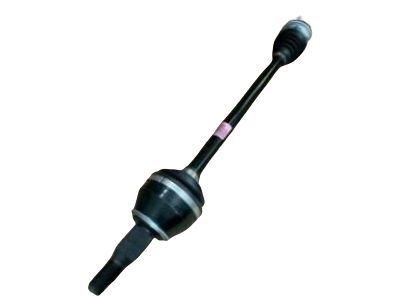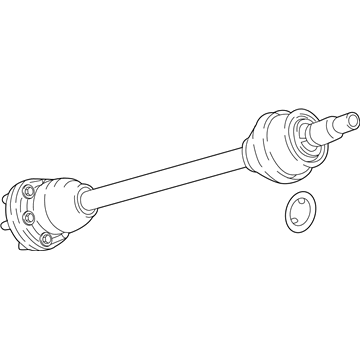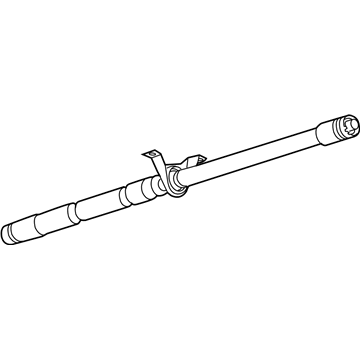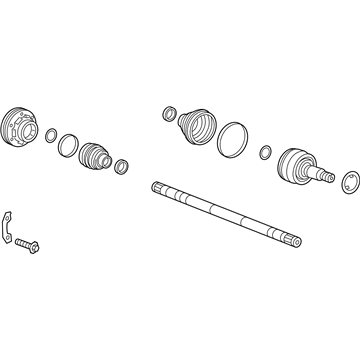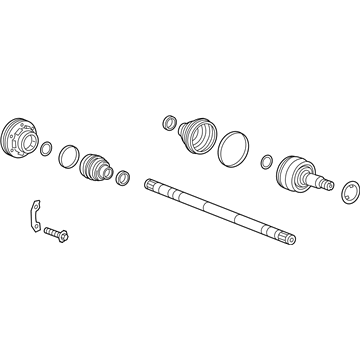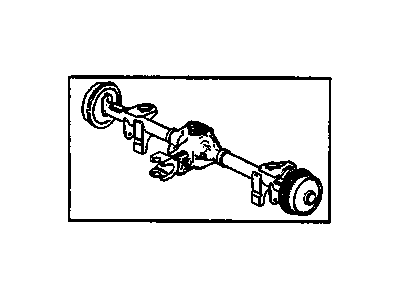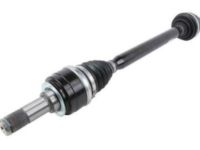
My Garage
My Account
Cart
Genuine Chevrolet Camaro Axle Shaft
Car Axle Shaft- Select Vehicle by Model
- Select Vehicle by VIN
Select Vehicle by Model
orMake
Model
Year
Select Vehicle by VIN
For the most accurate results, select vehicle by your VIN (Vehicle Identification Number).
39 Axle Shafts found
Chevrolet Camaro Rear Wheel Drive Shaft Assembly
Part Number: 23473011$406.45 MSRP: $662.46You Save: $256.01 (39%)Ships in 1-2 Business DaysChevrolet Camaro Rear Axle Shaft Assembly
Part Number: 84080683$115.79 MSRP: $198.02You Save: $82.23 (42%)Ships in 1-2 Business DaysChevrolet Camaro Rear Wheel Drive Shaft Assembly
Part Number: 23473010$572.74Ships in 1-2 Business DaysChevrolet Camaro SHAFT ASM-RR WHL DRV
Part Number: 85540672$233.36 MSRP: $399.04You Save: $165.68 (42%)Ships in 1-2 Business DaysChevrolet Camaro Rear Wheel Drive Shaft Assembly
Part Number: 84372864$318.54 MSRP: $503.45You Save: $184.91 (37%)Chevrolet Camaro Rear Axle Shaft Assembly
Part Number: 84371225$151.91 MSRP: $249.73You Save: $97.82 (40%)Chevrolet Camaro Rear Axle Shaft Assembly
Part Number: 84080684$128.83 MSRP: $213.22You Save: $84.39 (40%)Chevrolet Camaro Differential Carrier Cover Seal
Part Number: 23417962$82.25 MSRP: $136.13You Save: $53.88 (40%)Ships in 1-2 Business DaysChevrolet Camaro Rear Axle Shaft
Part Number: 23297260$170.69 MSRP: $282.52You Save: $111.83 (40%)Ships in 1-2 Business DaysChevrolet Camaro Rear Axle Shaft
Part Number: 23297261$205.59 MSRP: $340.26You Save: $134.67 (40%)Ships in 1-2 Business DaysChevrolet Camaro Rear Wheel Drive Shaft Assembly
Part Number: 22953759$1278.10 MSRP: $1722.51You Save: $444.41 (26%)Ships in 1-2 Business DaysChevrolet Camaro Shaft Assembly, Rear Whl Drv
Part Number: 84855967$224.00 MSRP: $377.31You Save: $153.31 (41%)Ships in 1-3 Business DaysChevrolet Camaro Rear Wheel Drive Shaft Assembly
Part Number: 84309454$179.70 MSRP: $297.42You Save: $117.72 (40%)Ships in 1-3 Business DaysChevrolet Camaro Shaft Assembly, Rear Whl Drv
Part Number: 84855964$168.51 MSRP: $268.75You Save: $100.24 (38%)Ships in 1-2 Business DaysChevrolet Camaro Shaft Assembly, Rear Whl Drv
Part Number: 84550240$334.02 MSRP: $552.83You Save: $218.81 (40%)Ships in 1-3 Business DaysChevrolet Camaro Shaft Assembly, Rear Whl Drv
Part Number: 84550239$326.40 MSRP: $540.21You Save: $213.81 (40%)Ships in 1-3 Business DaysChevrolet Camaro Shaft Assembly, Rear Whl Drv
Part Number: 84855968$179.87 MSRP: $297.71You Save: $117.84 (40%)Ships in 1-3 Business DaysChevrolet Camaro Shaft Assembly, Rear Whl Drv
Part Number: 84855963$181.25 MSRP: $299.98You Save: $118.73 (40%)Ships in 1-3 Business DaysChevrolet Camaro Shaft Assembly, Rear Whl Drv
Part Number: 84550231$183.74 MSRP: $304.10You Save: $120.36 (40%)Ships in 1-3 Business DaysChevrolet Camaro Rear Axle Assembly (3.42 Ratio)
Part Number: 12554921$2258.77 MSRP: $2920.20You Save: $661.43 (23%)Ships in 1-3 Business Days
| Page 1 of 2 |Next >
1-20 of 39 Results
Chevrolet Camaro Axle Shaft
The Axle Shaft of Chevrolet Camaro vehicles is one of the important assemblies which transmits the power generated by the differential to the drive wheels so that these wheels may rotate independently to obtain a better grip on the road. These steel shafts are crucial components in bearing vehicle weight; the torque it receives from driving and wheel alignment. Camaro Axle Shafts are of different types such as live axles for transmitting the torque, non-driving axle for suspension, straight axles for the heavy vehicle, and split axles for independent suspension. The differentials are installed in drive axles needed in the FW and RW layouts while the full-floating axles bear the load by casings in very massive automobiles. The main material of these tubes are chrome-molybdenum or carbon steel according to the necessity and demand for welding these tubes.
Each OEM Chevrolet Camaro Axle Shaft we offer is competitively priced and comes with the assurance of the manufacturer's warranty for the part. Furthermore, we guarantee the speedy delivery of your orders right to your doorstep. Our hassle-free return policy is also in place for your peace of mind.
Chevrolet Camaro Axle Shaft Parts Questions & Experts Answers
- Q: How to remove the axle shaft on Chevrolet Camaro?A:To remove the axle shaft from a vehicle, start by blocking the front wheels to prevent rolling. Then, loosen the wheel lug nuts and raise the rear of the vehicle, supporting it securely on jack stands. Remove the wheels and use a punch or small chisel to unstake the axle shaft/hub nut. Unscrew the axle shaft/hub nut with a socket and large breaker bar, discarding it and obtaining a new one for installation. Tap the end of the axle shaft with a soft-faced hammer to loosen it from the hub splines. If it's stuck, use a puller to push it from the hub. Disconnect the ABS wheel speed sensor electrical connector and remove the rear brake caliper. Detach the upper control arm from the knuckle and tilt the knuckle outward while pulling the axle shaft out of the knuckle. Remove the three-tang washer from the end of the axle shaft, discarding it and obtaining a new one for installation. Pry the inner end of the axle shaft out of the Differential and remove the axle shaft from the vehicle. To install a new axle shaft, apply a light film of grease to the inner CV joint stub shaft and insert it into the differential, ensuring the spring clip locks in its groove. Apply grease to the outer CV joint splines and the knuckle, then insert the outer end of the axle shaft into the hub. The rest of the installation is the reverse of removal. Install a new axle shaft/hub nut, tightening it to the specified torque and staking the collar into the axle shaft groove with a hammer and punch. Check the differential lubricant level and add more if necessary. Finally, install the wheels and lug nuts, lower the vehicle, and tighten the lug nuts to the specified torque.
Related Chevrolet Camaro Parts
Browse by Year
2024 Axle Shaft 2023 Axle Shaft 2022 Axle Shaft 2021 Axle Shaft 2020 Axle Shaft 2019 Axle Shaft 2018 Axle Shaft 2017 Axle Shaft 2016 Axle Shaft 2015 Axle Shaft 2014 Axle Shaft 2013 Axle Shaft 2012 Axle Shaft 2011 Axle Shaft 2010 Axle Shaft 2002 Axle Shaft 2001 Axle Shaft 2000 Axle Shaft 1999 Axle Shaft 1998 Axle Shaft 1997 Axle Shaft 1996 Axle Shaft 1995 Axle Shaft 1994 Axle Shaft 1993 Axle Shaft 1992 Axle Shaft 1991 Axle Shaft 1990 Axle Shaft 1989 Axle Shaft 1988 Axle Shaft 1987 Axle Shaft 1986 Axle Shaft 1985 Axle Shaft 1984 Axle Shaft 1983 Axle Shaft 1982 Axle Shaft

